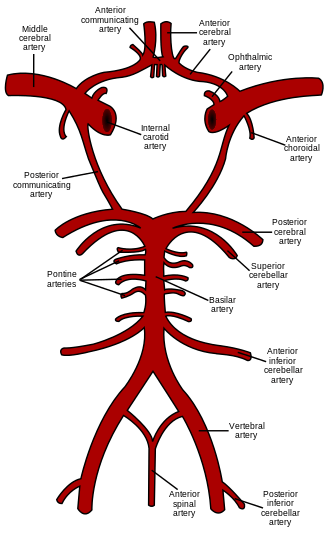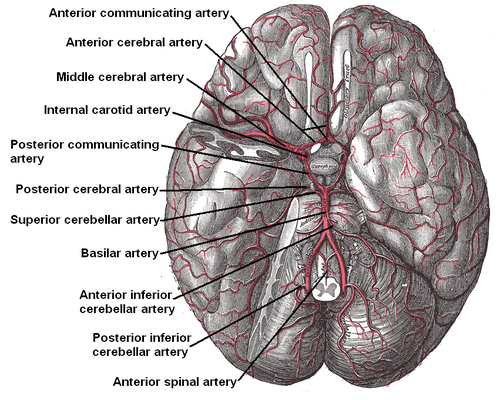Anterior communicating artery
| Anterior communicating artery | |
|---|---|
 The cerebral arterial circle and arteries of the brain. The anterior communicating arteries (top of figure) connect the left and right anterior cerebral arteries. | |
| Details | |
| Identifiers | |
| Latin | Arteria communicans anterior |
| TA | A12.2.07.029 |
| FMA | 50169 |
In human anatomy, the anterior communicating artery is a blood vessel of the brain that connects the left and right anterior cerebral arteries.
The anterior communicating artery connects the two anterior cerebral arteries across the commencement of the longitudinal fissure. Sometimes this vessel is wanting, the two arteries joining together to form a single trunk, which afterward divides; or it may be wholly, or partially, divided into two. Its length averages about 4 mm, but varies greatly. It gives off some of the anteromedial ganglionic vessels, but these are principally derived from the anterior cerebral artery.
It is part of the cerebral arterial circle, also known as the circle of Willis.
Pathology
Aneurysms of the anterior communicating artery are the most common circle of Willis aneurysm[1] and can cause visual field defects such as bitemporal heteronymous hemianopsia (due to compression of the optic chiasm),[2] psychopathology and frontal lobe pathology.[3]

References
This article incorporates text in the public domain from the 20th edition of Gray's Anatomy (1918)
- ↑ Beck J, Rohde S, Berkefeld J, Seifert V, Raabe A. Size and location of ruptured and unruptured intracranial aneurysms measured by 3-dimensional rotational angiography. Surg Neurol. 2006 Jan;65(1):18-25; discussion 25-7. PMID 16378842.
- ↑ Aoki N. Partially thrombosed aneurysm presenting as the sudden onset of bitemporal hemianopsia. Neurosurgery. 1988 Mar;22(3):564-6. PMID 3362325.
- ↑ Johnson MK, O'Connor M, Cantor J. Confabulation, memory deficits, and frontal dysfunction. Brain Cogn. 1997 Jul;34(2):189-206. PMID 9220085.
External links
- MedEd at Loyola Neuro/neurovasc/navigation/aca.htm
- Anatomy photo:28:09-0221 at the SUNY Downstate Medical Center
- Anatomy diagram: 13048.000-1 at Roche Lexicon - illustrated navigator, Elsevier
- Anatomy diagram: 13048.000-3 at Roche Lexicon - illustrated navigator, Elsevier